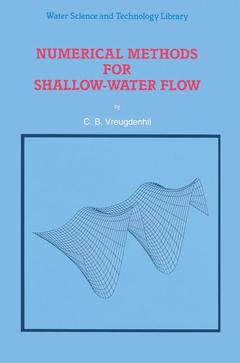Description
Numerical Methods for Shallow-Water Flow, Softcover reprint of hardcover 1st ed. 1995
Water Science and Technology Library Series, Vol. 13
Author: Vreugdenhil C.B.
Language: English
Subjects for Numerical Methods for Shallow-Water Flow:
Keywords
Publication date: 12-2010
262 p. · 16x24 cm · Paperback
262 p. · 16x24 cm · Paperback
Description
/li>Contents
/li>Comment
/li>
A wide variety of problems are associated with the flow of shallow water, such as atmospheric flows, tides, storm surges, river and coastal flows, lake flows, tsunamis. Numerical simulation is an effective tool in solving them and a great variety of numerical methods are available. The first part of the book summarizes the basic physics of shallow-water flow needed to use numerical methods under various conditions. The second part gives an overview of possible numerical methods, together with their stability and accuracy properties as well as with an assessment of their performance under various conditions. This enables the reader to select a method for particular applications. Correct treatment of boundary conditions (often neglected) is emphasized. The major part of the book is about two-dimensional shallow-water equations but a discussion of the 3-D form is included.
The book is intended for researchers and users of shallow-water models in oceanographic and meteorological institutes, hydraulic engineering and consulting. It also provides a major source of information for applied and numerical mathematicians.
The book is intended for researchers and users of shallow-water models in oceanographic and meteorological institutes, hydraulic engineering and consulting. It also provides a major source of information for applied and numerical mathematicians.
1. Shallow-water flows.- 2. Equations.- 3. Some properties.- 4. Behaviour of solutions.- 5. Boundary conditions.- 6. Discretization in space.- 7. Effects of space discretization on wave propagation.- 8. Time integration methods.- 9. Effect of time discretization on wave propagation.- 10. Numerical treatment of boundary conditions.- 11. Three-dimensional shallow-water flow.- List of notation.- References.
A wide variety of problems are associated with the flow of shallow water, such as atmospheric flows, tides, storms surges, river and coastal flows, lake flows, tsunamis. The first part of the book summarizes the basic physics of shallow-water flow needed to use numerical methods under various conditions. The second part gives an overview of possible numerical methods, together with their stability and accuracy properties as well as with an assessment of their performance under various conditions. This enables the reader to select a method for particular applications. Correct treatment of boundary conditions (often neglected) is emphasized. The book is intended for researchers and users of shallow-water models in oceanographic and meteorological institutes, hydraulic engineering and consult
© 2024 LAVOISIER S.A.S.



